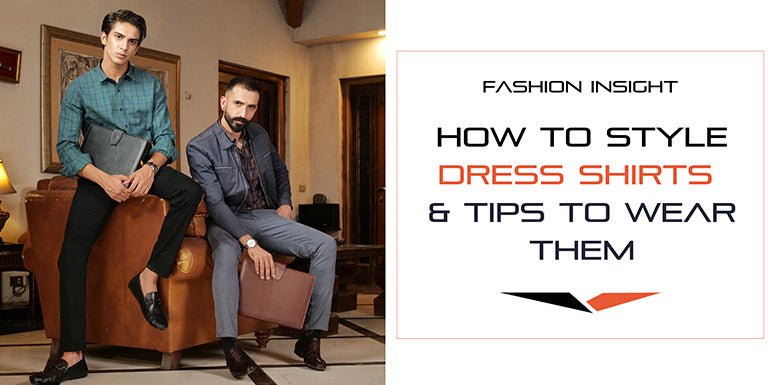When we say dress shirt, what’s the first thought that comes to your mind? The shirts men wear with their formal outfits, probably? And that thought isn’t wrong. Yet, there’s so much more to these shirts than just their association with formal clothing. But to know all of that, it’s necessary to first look into a bit of the history of this timeless part of men’s wardrobe.

Believe it or not, dress shirts were first introduced in men’s clothing as a form of undergarment, designed for the purpose of protecting high-quality waistcoats from dirt. But the socialite, Beau Brummell, emphasized highly on wearing styled and perfectly clean linen, bringing more importance to dress shirts than they were previously given. And by the 19th century, these undergarments had resumed their own status as separate pieces of clothing.
By the turn of the 19th century and the arrival of the 20th century, dress shirts started gaining more prominence in the eyes of the public, becoming a symbol of gentlemen. But even so, they needed to be regularly cleaned to make their mark, especially with their removable-collar design that made it harder for them to get cleaned. Some Victorian-era men also started to wear paper collars to ensure cleanliness. Then, during the 1920s, the Duke of Windsor introduced the design of turned-down collars, as an alternative to stiff-winged collar shirts.
By the 1960s, men’s dress shirts became fancier with more ornate styles, with huge ruffles, embroideries, etc. This carried on for a while until the beginning of 2000 when men went back to more traditional styles of dress shirts. Now, any shirt with a collar, attached or detached, is considered as a dress shirt that’s usually worn with a suit and a tie.

Of all the men’s clothing options, dress shirts may seem like they’re the easiest outfit to choose. But whether you want to wear them in a formal outing, a professional meeting, or a casual retreat, it’s essential for your dress shirts to be right for the occasion. And different occasions mean different styles and colors of outfits that you’re going to match your shirt with, regarding their designs as well as fit. So let’s get into the styling of these clothes and some of our personal suggestions for you to own an appropriate wardrobe.
Styling Your Dress Shirts
When it comes to men’s formal shirts, it’s important that you are wearing the right fit during the right occasion. A too-tight or too-loose shirt will not be much for making an impression. Consider the guide provided by us, the next time you’re shopping for dress shirts.
Classic Fit
One of the more traditional styles, the classic fit has a boxier shape with long sleeves and a relaxed waist design. This shirt allows the wearer to move freely, unlike more streamlined, tighter fits. Though it’s not a good style for slimmer frames, it can do well for men who need more room in the midsection.
Slim Fit
The most popular of dress shirts, slim fitted styles provide a more tailored, trendier, and sleeker look compared to the classic fit. They’re more distinguishable and a good fit for men with a slimmer physique.

Modern Fit
Sitting between slim and classic fits, the modern fit provides a look combining tight and flexible. This fit keeps the comfort levels of the classic yet also emphasizes the sleek fit of the slim shirts.
Though we’ve mentioned only three, there are many different fits for these shirts that you can choose from, as long as it’s a good fit for you and matches with your outfit and the occasion you’re wearing it for. And with that, we come to the next section of our discussion, i.e. tips to wear different colors and patterns of dress shirts.
Tips to Wear Different Colors & Patterns of Dress Shirts
White & Black
While not many shirt colors stand the test of time, the white and black colored shirts are more timeless pieces that never go out of style. White was specifically the first choice for men during the 18th and 19th centuries, while black made its way into a trend during the 20th and 21st centuries. Both these colors are considered to be the most formal and traditional looks that men can carry, providing a classy and stylish appearance.
Considered a sign of power and influence, you can’t go wrong with the white or black colors when it comes to important business meetings and formal occasions. You can easily pair these colors with dark-colored trousers and a coat on top if you’re attending a formal meeting. Though, black is also considered a stylish choice for more informal occasions.
Other Solid Colors
Light pink, gray, light blue, off-white, and even brown are all considered good colors to wear when it comes to formal dress shirts. Navy, on the other hand, is more suited to informal smart-casual dressing, though it’s also not a bad option for formal occasions.

Striped Pattern
There are many different striped variants to choose from, though they’re not very indicative of formal wear, they’re still a good choice that can make a positive impression. These strips add a sense of individual style to your outfit, and if you know how to pair your suit well with matching shoes, you’re good to go.
Checkered Pattern
This is another good option, especially for a more smart casual look. Pair these shirts with a jacket or blazer, and you have the perfect professional yet laid-back and relaxed appearance at your disposal.

In the end, there are too many dress shirt styles to choose from, but in the end, you need to go for what best describes your personality while also leaving a positive and strong impression on those you meet. We hope our guide has helped you steer your wardrobe in the right direction. If you’re looking for more from the men’s fashion collection, visit the FHS Magazine.
Shoes for you




















